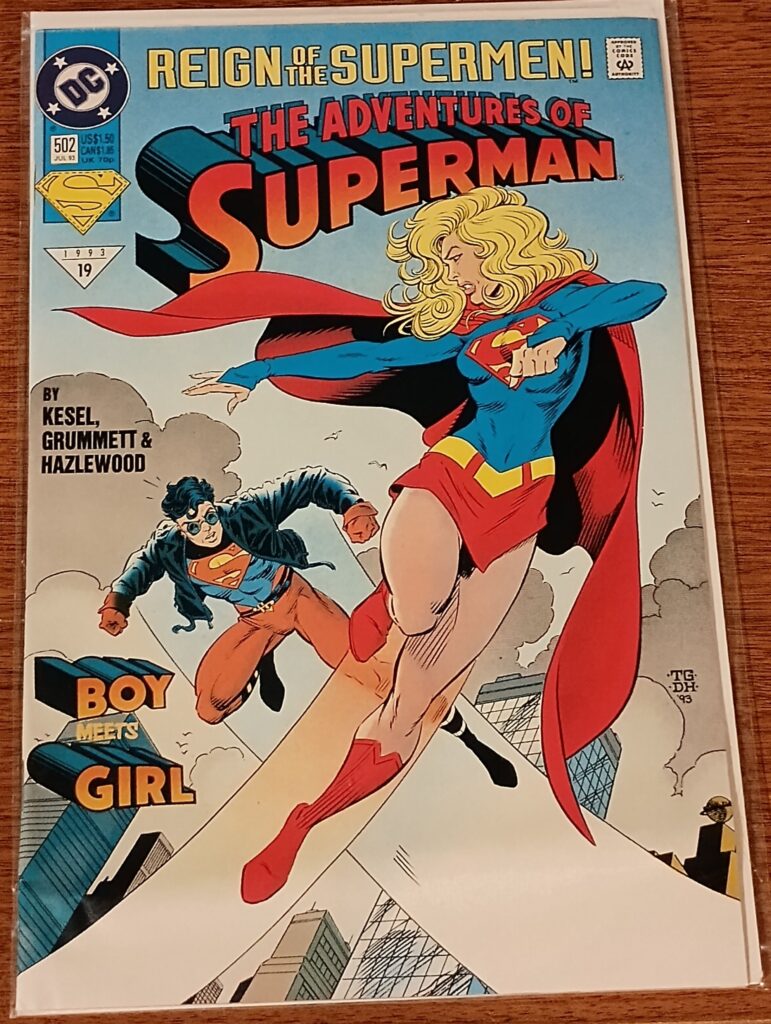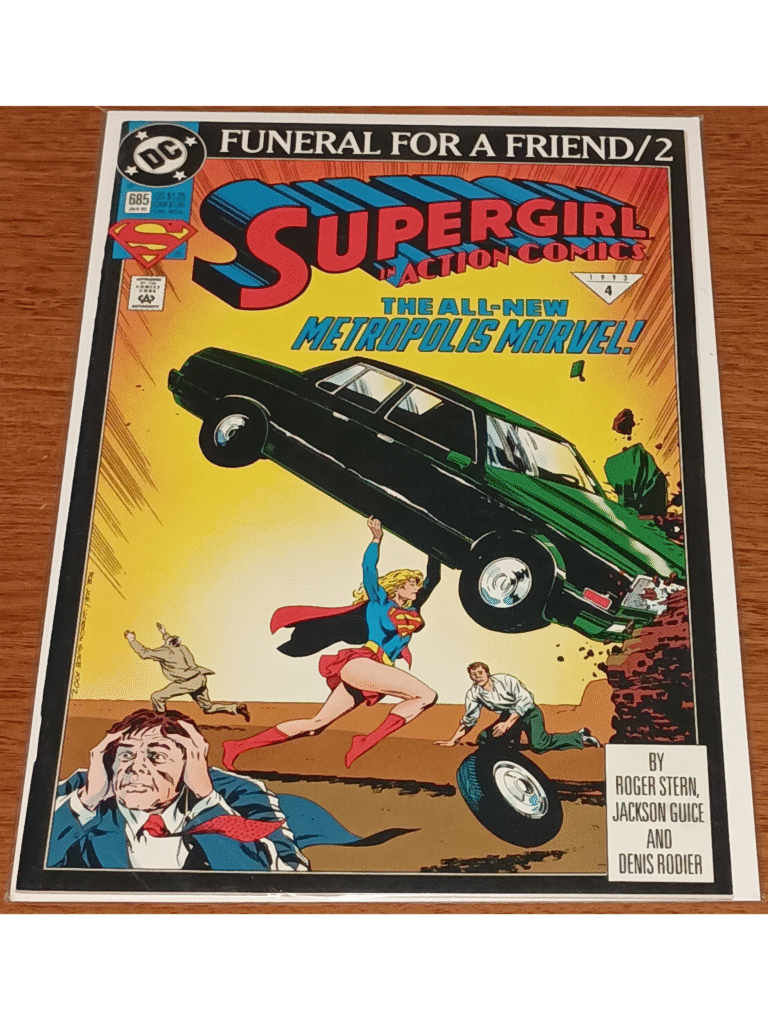If you’re curious about the Silver Age Supergirl origin story, you’ve come to the right place. In this post, we’ll dive deep into how Kara Zor-El first soared into DC Comics’ universe, exploring her background in Argo City, her dramatic journey to Earth, and the circumstances that shaped her early adventures. Whether you’re a longtime collector or a new fan wanting a clear, informative overview, this guide has you covered—no fluff, just the fascinating specifics that make the Silver Age Supergirl one of the most enduring heroines in comics.
Why the “Silver Age Supergirl Origin Story” Matters
During the Silver Age of comics (roughly the late 1950s through the early 1970s), DC reimagined many of its characters with fresh backstories, science-fiction twists, and vibrant new art styles. Although Superman debuted in 1938, it wasn’t until 1959 that his cousin, Kara Zor-El, graced the pages of DC’s universe. Her introduction—captured in Action Comics #252—filled a gap in Superman lore and opened the door for countless adventures centered around a Kryptonian heroine.
When searching “Silver Age Supergirl origin story,” fans often look for:
- Historical context: How and why DC decided to bring Supergirl into the fold during the late 1950s.
- Key issue details: Issue numbers, publication dates, creators, and cover art descriptions.
- Character backstory: Kara’s life on Argo City, her relationship to Kal-El (Superman), and the events that forced her escape.
- Early identity: How Kara adopted the secret identity “Linda Lee” and balanced ordinary life with extraordinary powers.
If you want to appreciate how the Girl of Steel evolved into a pop-culture icon, understanding the Silver Age Supergirl origin story is essential. Let’s get started!
The Birth of a Hero: DC’s Decision to Create Supergirl
By 1958, Superman had enjoyed two decades of success across comic books, radio, and television, but fans clamored for new Kryptonian adventures. DC’s editorial team—led by Mort Weisinger—saw an opportunity to expand Superman’s mythos by introducing a female counterpart. The idea was simple yet powerful: give Superman a cousin who could match his strength, but still grapple with youthful curiosity and a desire to prove herself.
- Key Creators: Otto Binder (writer) and Al Plastino (artist) are credited with crafting the concept and look of the first Silver Age Supergirl.
- Publication Premiere: Action Comics #252 (May 1959) marked Supergirl’s debut. The cover famously teases “Look! Up in the sky! It’s a bird! It’s a plane! It’s Supergirl!” in bright, bold lettering.
- Visual Design: While Superman’s iconic “S” shield remained the same, Supergirl’s costume added a skirt and a shorter cape. Her youthful bob haircut and big, friendly eyes captured the optimistic tone of Silver Age storytelling.
DC aimed to tap into the same spirit of hope and wonder that made Superman a household name—only this time through the lens of a teenage Kryptonian adjusting to life on Earth.
Kara Zor-El’s Backstory on Argo City
Understanding the Silver Age Supergirl origin story means first traveling to Argo City, the floating Kryptonian colony that survived Krypton’s destruction. While Superman’s home planet exploded, destroying nearly every vestige of Kryptonian civilization, Argo City endured—at least for a time. Here’s a quick breakdown:
- Argo City Explained: In Silver Age continuity, Argo City floated on a chunk of Krypton after the planet’s core implosion. Magnetic fields kept this remnant afloat, preserving its inhabitants, including Kara.
- Kara’s Early Life: Born as Kara Zor-El, she was Superman’s cousin—Kal-El’s only surviving Kryptonian relative in Argo. She grew up idolizing her cousin’s heroic legacy, even before she knew of his existence on Earth.
- Catastrophic Events: A meteor shower (often attributed to the same cosmic event that shattered Krypton) poisoned Argo’s life-supporting atmosphere. With time running out, faces behind Argo’s science council realized they had to send Kara to safety—far from the dying world.
These details ground the Silver Age Supergirl origin story in a compelling narrative: Kara isn’t just another cast member; she’s the last hope of an entire Kryptonian outpost.
The Journey from Argo City to Earth
One of the most memorable aspects of the Silver Age origin is the dramatic escape that brought Kara to Earth:
- Mother’s Plea: Before Argo City’s atmosphere became unbreathable, Kara’s mother (Alura In-Ze) and father (Zor-El) boarded a one-way rocket ship. Their mission? Evacuate Kara and send her to join Kal-El on Earth.
- Two-to-One Time Dilation: A classic Silver Age plot device meant Kara only aged weeks en route, despite the journey taking months in Earth time. This explains how she arrives at roughly the same age as Superman, despite Krypton’s destruction happening years earlier.
- The Broken Rocket: Mid-journey, the ship’s navigation systems fail, sending Kara off course. Due to Kryptonian physiology, she survives the crash—but not without consequences: her ship lands near the small town of Midvale, USA, establishing her first human connections.
Because of these twists, the Silver Age Supergirl origin story balances cosmic tragedy with a classic fish-out-of-water scenario. By the time Kara reaches Earth, readers already feel invested in the fate of Argo City and eager to see how this young Kryptonian adapts to her new home.

Adopting “Linda Lee”: A Secret Identity Is Born
On Earth, Kara crash-lands in a yet-unspecified rural area (later retconned as Midvale). An unsuspecting couple—John and Margot Barnes—discover her unconscious body near a riverbank. Knowing any kid alone was suspicious, they decide to take her in. With obvious Kryptonian physiology (super strength, invulnerability), Kara’s new caretakers had to keep her hidden from prying eyes. Here’s how that unfolded:
- New Name, New Life: John Barnes suggests “Linda Lee” as a fitting human name. The alliteration echoes both “Lois Lane” and “Charlie Brown,” giving Kara a memorable identity.
- Life with the Barneses: John and Margot enroll Linda Lee in Midvale High School. To avoid suspicion, she keeps her powers secret—only using them when absolutely necessary.
- Learning Earth Customs: Like any teenager, Linda navigates school, friendships, and extracurricular activities. But unlike her classmates, she must juggle studies with clandestine heroics whenever danger strikes.
This dual-identity concept—Supergirl by night, Linda Lee by day—mirrors her cousin’s setup and cements her as an accessible character: readers see her struggle with homework one moment and save a bus full of passengers the next.
Kara’s Powers and Early Adventures
Because she shares Superman’s Kryptonian DNA, Kara Zor-El boasts a suite of superpowers from the moment she steps foot on Earth. A quick rundown:
- Super Strength & Invulnerability: Able to bench-press trucks and shrug off bullets. Early stories delight in showing her lifting cars almost accidentally, given her unfamiliarity with Earth’s gravity.
- Flight: In the Silver Age, flight is often described as “leaping tall buildings at a single bound,” though most modern retellings grant her true flight (matching Superman’s speed).
- Heat Vision & X-Ray Vision: Debuted gradually. Initially, she displays imprecise heat vision that takes practice, underscoring her youthful inexperience.
- Super Speed & Super Hearing: Able to outrun cars and hear distress calls from miles away.
Early adventures in Action Comics and her own short backup series often highlight:
- Balancing High School & Heroics: Linda Lee once almost missed her prom after stopping a runaway train—classic teenage drama meets hero problem.
- Protecting Argo City Memories: Though Argo City’s fate is sealed, Kara’s early stories sometimes show her interacting with holographic records of her home, preserving its legacy.
These elements—her raw power tempered by teenage curiosity—define the Silver Age Supergirl origin story as a blend of cosmic stakes and relatable high-school trials.
Publication Notes & Key Issues
If you’re collecting Silver Age issues or simply want to revisit Kara’s earliest moments, here are the essentials:
- Action Comics #252 (May 1959): Kara Zor-El’s first appearance. Written by Otto Binder, art by Al Plastino. Cover features Supergirl battling an alien invasion alongside Superman.
- Action Comics #285 (May 1962): The first time Supergirl receives her own serialized spotlight in “Supergirl’s Tale of Adventure.” These backup stories (through #320) let readers see her tackle situations independently of Superman.
- Adventure Comics #271 (April 1960): A pivotal issue where Supergirl faces her first major nemesis, the Silver Scarab. Collectors prize this for the introduction of one of her earliest villains.
- Action Comics #282 (February 1961): Includes a memorable Silver Age episode where “Linda Lee” wins a school science fair with her uncanny knowledge of Kryptonian technology.
Most Silver Age issues are affordable—ranging from $20 to $50 in average condition—though pristine copies can fetch significantly more. If you’re a collector, look for copies graded CGC 9.0 or higher to secure that glossy, crisp “Silver Age” shine.
Cultural Impact & Lasting Legacy
The Silver Age Supergirl origin story did more than introduce a new character—it expanded DC’s potential for storytelling:
- Gender Representation: Before Supergirl’s arrival, DC had very few prominent female superheroes outside Wonder Woman. Kara helped prove that female leads could carry stories (even if often in Superman’s shadow).
- Teenage Hero Archetype: While Batman’s Robin existed earlier, Linda Lee’s high-school setting combined normal teenage issues with cosmic adventures, influencing later characters like Mary Jane Watson’s “Amazing Mary Jane” or even Peter Parker’s challenges.
- Ongoing Reboots & Retcons: Although Crisis on Infinite Earths (1985) temporarily removed Kara from continuity, DC repeatedly revived and reimagined her, often referencing her Silver Age origin. Even in modern comics—Rebirth, Infinite Frontier—writers nod to those first Silver Age issues as foundational.
Ultimately, Kara’s journey from Argo City to Earth paved the way for female Kryptonians of multiple eras: New 52’s younger Kara, Post-Crisis Matrix/Linda Danvers, and beyond.
Why Every Fan Should Read the Silver Age Origin
Whether you’re a collector hunting for key issues or a fan wanting to understand Kara’s DNA, the Silver Age Supergirl origin story is a must-read. Here’s why:
- First Glimpse of Kara Zor-El: You see her raw emotion—torn between loyalty to family (Argo City) and the realization that Earth needs her.
- Classic Silver Age Art & Storytelling: Witness Al Plastino’s bright, optimistic art style and Otto Binder’s knack for sci-fi lore and teenage nuance.
- Foundation for Future Eras: Later writers—even when rebooting or retconning—often pay homage to this origin. Familiarity with the Silver Age arc deepens appreciation for modern reinterpretations.
- Accessibility: Most Silver Age issues are readily available in back-issue bins, online marketplaces, or affordable reprints, making it easy for new readers to grab a copy without breaking the bank.

For anyone passionate about comic book history, starting at the source—Action Comics #252—is like discovering the Rosetta Stone of Supergirl’s legacy.
The Timeless Appeal of Kara’s First Flight
The Silver Age Supergirl origin story remains a shining example of how DC’s Silver Age reinvention created characters that still resonate today. From the tragic fall of Argo City to Linda Lee’s awkward first day of school, these early tales capture a unique blend of cosmic wonder and teenage drama. By reading Action Comics #252 and its subsequent backup tales, you’ll experience firsthand the birth of a heroine whose influence continues to ripple through DC’s multiverse.
Ready to embark on Kara’s journey? Hunt down that iconic Action Comics #252—immerse yourself in colorful, hopeful Silver Age storytelling, and witness how Supergirl first earned her place among the pantheon of legend.




